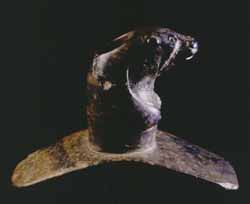
 |
Otter platform pipe, Ethel Wilson site, White County. | |
|
In the Middle Woodland period, Native Americans made stone smoking pipes. Often, the bowl of the pipe was carved into the shape of an animal such as the otter seen here. In addition to the otter, Middle Woodland people carved pipe bowls into a bird such as a raven, cardinal or falcon; a mammal such as a beaver, deer, or wolf; or an amphibian such as a frog or toad. These animal sculptures also inform us about the kinds of animals lived 2,000 years ago. |
||
All of the Woodland period animals would be familiar to us today. Except for the elk (Cervus elaphus), most of these animals still live in the wild in Illinois. Woodland period mammals included white-tailed deer (Odocoileus virginianus), raccoon (Procyon lotor), rabbit (Sylvilagus), beaver (Castor canadensis), otter (Lutra canadensis), and many other species. Reptiles, including turtles and snakes, and such amphibians, as frogs and toads also were common during the Woodland period. There was also a variety of birds that are still common today, including song birds, birds of prey such as hawks and eagles, and waterfowl. The greatest difference between animals of today and the Woodland period is found among fish and freshwater mussels. Some species of fish though still present are rare, and many species of mussels are no longer found in certain Illinois streams due to siltation and chemical pollution.
|
|
Copyright © 2000 Illinois State Museum